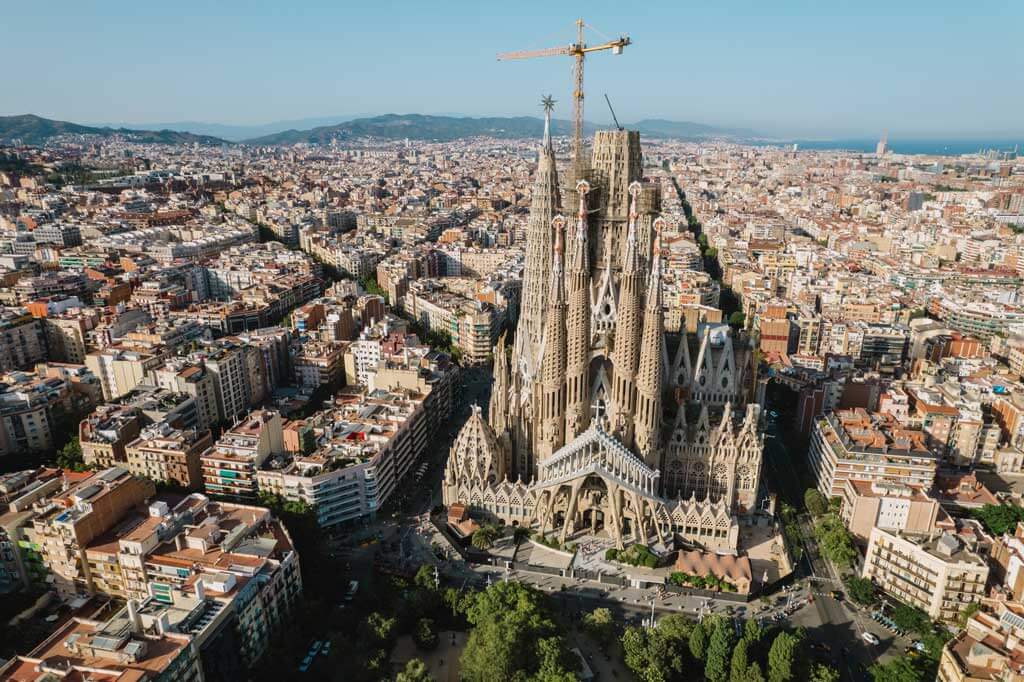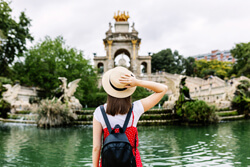One of Barcelona’s most famous landmarks, the Sagrada Familia, is the symbol of Catalonia. Located in the Eixample neighborhood, it astonishes visitors with its peculiar architecture.
Designed by the legendary architect Antoni Gaudí, the Sagrada Familia is the world’s largest unfinished church. However, construction is still underway, and it aims to carry out Gaudì’s project of building a site of grandeur and glory.
Read this Sagrada Familia guide with my tips for visiting the Sagrada Familia and all the secrets behind this unmissable landmark.
Sagrada Familia History

The Sagrada Familia is an expiatory temple, which means it is built with the donations of the faithful. With the money collected, the construction of the temple began in 1882 under architect Francisco de Paula del Villar.
However, at one point, the architect resigned, and the project was taken up by young Antoni Gaudí in 1883. Thanks to a very generous donation, Gaudí could change the design of the Temple, a more ambitious project that mixed Neo-Gothic with Modernist elements.
Relying solely on private donations, the construction of the Sagrada Família progressed incredibly slowly and was interrupted by the Spanish Civil War.
With Gaudi’s death in 1926, only a quarter of the Sagrada Familia’s project had been completed. The construction of this holy site resumed in the 1950s, and the current building plan has set the work deadline for 2026.
How to Visit Sagrada Familia
When planning your visit to the Sagrada Familia, you might wonder where and how to purchase the entrance tickets.
The first thing to know is that Sagrada Familia tickets cannot be bought directly at the site. Instead, you must buy them through the official or partner websites like Tiqets or GetYourGuide.
The tickets go on sale two months in advance and sell out fast, so I suggest buying your Sagrada Familia entrance as soon as possible.
Based on the ticket type you buy, you will need to access the Sagrada Familia from one of the three main access points: Gate A (for VIPs), Gate B (for Groups), and Gate C (for individual tickets). They are all located opposite the Nativity Façade on Carrer Marina. Access for school groups is instead located on Carrer de la Sardenya.
Dress correctly. Remember that you are visiting a religious place. It is also not allowed to visit with caps or transparent clothing.
The proceeds from the sale of Sagrada Familia tickets (after salaries, entertainment, and taxes) contribute to the construction of the church.
1. Self-guided Visit

If you opt to visit the Sagrada Familia self-guided, you must choose a date and time slot when purchasing your ticket. You must also decide whether to access the towers and buy the ticket accordingly.
The self-guided ticket includes a handy audio guide, which you can download by following the link provided in the confirmation email.
With this ticket, you will access the Temple through Gate C. This is the gate that sees the longest lines. Note that every visitor has to pass a series of control checks similar to any airport’s checks, so there is some extra waiting time, especially if you are visiting during the tourist season.
TIP: Some Barcelona tourist cards, like the Barcelona Pass and the Best of Barcelona Bundle, include access to the Sagrada Familia, and will save you money! Check out the best Barcelona City Passes here.
2. Visit Sagrada Familia with a Guided Tour for the Best Experience

If you decide to visit the Sagrada Familia with a guide, you will enter through access B, which has zero waiting lines.
In addition to fast access, I highly recommend opting for a guided tour of the Sagrada Familia since there is a lot of symbolism on the façades and inside. Unlike the façades, the interior is very empty, but a good guide will point you to all the interesting things in the architecture to see.
If choosing a guided tour with access to one of the towers (I booked and I recommend this one), the guide usually accompanies the group to the tower’s lift and briefs you about what to see, where to look, and how to visit, but he does not go up with you.
Note that the guided tour at the Sagrada Familia does not include the Museum and the Crypt. After the guided tour, you can visit them by yourself without paying any additional fee.
Sagrada Familia – What to See
1. The Basilica


Although incomplete, the Basilica of the Sagrada Familia is truly a magnificent piece of architecture. It boasts three major façades, each dedicated to a different aspect of Jesus’s life.
The Nativity Facade, facing east, is the oldest and symbolizes the birth of Jesus. The Passion Facade, facing west, is dedicated to Jesus Christ’s death and resurrection. The third is the Glory Facade, facing south, which is dedicated to Christ’s glorious nature. This is also the Basilica’s main entrance.
Gaudí was inspired by nature to build the Sagrada Familia. As you walk through the Basilica, your gaze will be caught by the high ceiling with columns and colorful windows. The massive columns resemble trees growing in a forest, while the magnificent stained-glass windows have different colors to symbolize the birth and the Passion of Jesus Christ.
TIP: Here’s how to visit Sagrada Familia for free!


At the center of the building is the altar. Here, the ceiling is higher than the rest of the church to accentuate the divinity of the act performed there. The sculpture of Christ on the Cross that adorns the altar is made of clay.

2. Towers

The Sagrada Familia has two towers that can be visited: the Nativity Tower and the Passion Tower. To access each tower, you need a separate ticket.

Are the Sagrada Familia Towers worth it? In my opinion, YES. If you’re looking for panoramic views, there are other points with better views. The visit to the towers is a great and unforgettable experience and an excellent way to recreate yourself in the construction details.
Both towers are high and might be closed in bad weather conditions. If this is the case, the cost of the visit to the tower will be refunded (but not the cost of the visit to the Basilica).
To ascend the Towers, you will have to leave your bag in special lockers and collect it once you descend.
To ascend the Towers, you will take a lift. However, note that to descend, there is no lift but 400 steps to walk through a very narrow staircase, so it is unsuitable for people with reduced mobility or claustrophobia.


Sagrada Familia Nativity Tower or Passion Tower? The Passion Tower is usually less crowded than the Nativity Tower. The Passion Tower is oriented towards the sea and the views of the city are better, while the Nativity Tower has more artistic details. If you decide to visit the Nativity Tower, you will have the possibility to walk across a bridge that connects the two central towers of this façade.
3. Crypt
The Crypt of the Sagrada Familia can only be visited if you attend the mass. The access is free of charge. The crypt usually opens a few minutes before the mass, enough time to visit the crypt and take pictures. Mass times in the crypt are:
- Working days: 9 a.m. (Spanish); 10 a.m. (English); 8 p.m. (Catalan)
- Saturdays: 9 a.m. (Spanish)
- Sundays and holidays: 10:30 a.m. (Catalan); 11:45 a.m. (Spanish); 1:00 p.m. (Catalan); 6:30 p.m. (Spanish); 8:00 p.m. (Catalan).

The crypt also houses Gaudí’s tomb, which is located in the Nostra Senyora del Carme Chapel.
The crypt’s floor is decorated with a Roman mosaic and listed as a UNESCO World Heritage Site.
< Gaudi’s Tomb inside the Crypt
4. Museum

The Sagrada Familia’s Museum is dedicated to the Basilica and Gaudì’s plans for its construction. It also contains information about other Gaudi works. This is an interesting area to stop by, especially if you decide to self-tour the Sagrada Familia.
Access to the Museum is included in all the Sagrada Familia tickets. When facing the Passion Facade, the entrance to the Museum is on your right.
5. Gaudi’s Workshop in the Sagrada Familia


When facing the Passion Facade, you will see Gaudi’s Workshop on your left. During the last years of his life, it was also the place where Gaudi lived.
Although the building is not open for visitors, you can see a replica of the interior inside the Museum.
Best Time to Visit Sagrada Familia
The Sagrada Familia is open every day, but there are better days and times to visit.
From November to February, it is open Monday – Saturday, from 9:00 a.m. to 6:00 p.m.; on Sundays, access is from 10:30 a.m. to 6:00 p.m.
From April to September, it is open Monday through Friday from 9:00 a.m. to 8:00 p.m., Saturday from 9:00 a.m. to 6:00 p.m., and Sunday from 10:30 a.m. to 8:00 p.m.
In March and October, the Sagrada Familia is open Monday through Friday from 9:00 a.m. to 7:00 p.m., Saturday from 9:00 a.m. to 6:00 p.m., and Sunday from 10:30 a.m. to 7:00 p.m.
1. Best Day to Visit Sagrada Familia to Avoid the Crowds
The best day to visit the Sagrada Familia to avoid the crowds is Monday since it is the day of the week that records fewer entrances.
On the contrary, weekends (Friday, Saturday, and Sunday) are usually the busiest days.
2. Best Time to Visit Sagrada Familia to Avoid the Crowds
The best time to visit the Sagrada Família to avoid the crowds is in the morning when it opens at 9:00 a.m.
The period from 9:00 to 10:00 in the morning is relatively less crowded than the rest of the day.
The longest lines are between 11:00 a.m. and 1:00 p.m., which are also the hottest hours to wait in line.
3. Best Time to Visit Sagrada Familia to See the Interiors
The magnificent windows of the Sagrada Familia are at their best between 5:00 and 6:00 p.m., when the afternoon sun shines through them, filling the church with astonishing colors. The Sagrada Familia becomes a dreamlike venue at sunset!
Not surprisingly, many tourists plan their visit around the golden hour.
4. Best Time to Visit Sagrada Familia to Take Nice Pictures
The ideal time to take pictures outside is sunrise, first thing in the morning, for the Nativity Façade in the east, and sunset for the Passion Façade in the west.
The colors of the Sagrada Familia inside change during the day due to sunlight. The stained glass in the east is yellow and blue, while the stained glass in the west is orange and red. Take advantage of this variation to get a wide range of photos with different moods and nuances.


The magnificent windows of the Sagrada Familia are at their best between 5:00 and 6:00 p.m., when the afternoon sun shines through them, filling the church with astonishing colors. The Sagrada Familia becomes a dreamlike venue at sunset! After that time, the photos of the interior of the Temple are very dark.
Beware that tripods, not even flexible mini-tripods, are not permitted. For safety reasons, photo tablets, large hats, large backpacks, etc., are not allowed, and the use of flash is prohibited.
Where to Sleep Near the Sagrada Familia
As you make your bed, so you lie. Find the right accommodation near the Sagrada Familia – whether it’s a hotel or guesthouse, holiday apartment, or private apartment – I have them all! Book your accommodation by using the map below.
And there you have it, a quick Sagrada Familia guide to get the most out of the Sagrada Familia in Barcelona.


